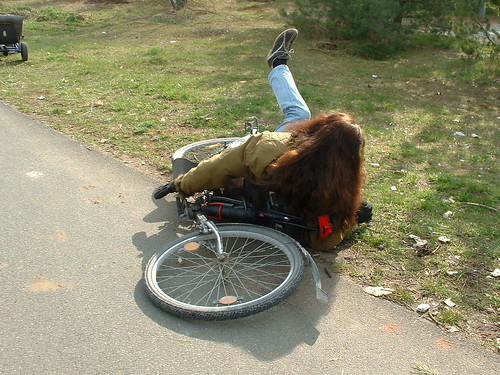Learning To Ride The Python

|
|---|
| The Joy of Learning |
Unlike other bikes learning to ride a python takes a lot of time and persistence. You will know you have mastered the bike when you do not more notice riding it; i.e. when the bike takes no conscious effort at all.
Learning to ride the python is much akin to learning to ride a regular bike while you were little. This will be a large investment, but apart from the goal of mastering the bike, even the learning phase itself can be very rewarding! You get the chance to be a child again.
Practice Duration
At first the riding progress is counted in meters. After a few days the novice is able to ride straight lines and wobbly curves, but still needs lots of safety-space for his lateral movements.
About 300 km of practice is necessary before one feels save on the Python and dares to ride in normal traffic. 300 km may seem like much, but note that the first 10 kms will take the most of the time! Adding the other 290 kms is peanuts! ;-)
Another 1000 km are needed to achieve the masters degree of riding skills. From now one the rider can run the Python under its full performance.
The Subconscious or Center Person
We have to ride much kilometers to give the possibility to our brain to write a new program of coordination (it is like learning to walk). The result is a synergy between body and machine, whose coordination will be constantly controlled by this unconscious flowing new motion-program. We need patience and tenacity to practice, and to let our body/brain/subconscious repeat and repeat and repeat; don't worry, we can trust in it! It seems that the subconscious (the center-person) is much more efficient then the conscious (the "I-person") --- the data-flow-rate of the unconscious is much higher.
This process needs time, a lot of time of practice.
Tips that help
Choose a large empty parking lot without spectators that might irritate you. In the beginning let the bike go wherever it wants, just try to keep it balanced. After a while try softly to influence the direction of the course. Do not exaggerate the practice. Half an hour up to one hour per day is enough.
Take your gloves on. The seat is low on a python, and you can reach the ground while cycling. A good way to learn to drive is by keeping balance with your hands while steering with your legs. If your seat is too high you could also use two short sticks instead of gloves (like Skiing)
For those who have handlebars attached, using gloves will help move the focus away from the handlebars to steering with the legs. Only in a later stage you should be touching your handlebars, as the handlebars are really not meant to do the steering. They are useful for both the fine work or damping a wobble away.
When your are a further in the practice, you might try riding with eyes closed. This way you will feel if or where in your body you are tensed up. The key to riding a python well is learning to relax your whole body and lying well into the seat. The more relaxed your body is the better your body will be able to control the bicycle.
Don´t give up! It takes time! A bike is ridden by the subconscious, and riding the python is not different. The problem you will be faced with will be two fold. First the thinking part of you must learn to release control, and let your subconscious take over (you have to learn to relax). The second part of the problem is giving time to build up confidence in your subconscious. At a later stage of mastery, loss of control is really caused by panic. Panic causes you to focus on steering, thereby setting your subconscious aside and trying to control the bike rationally. This won't work. Therefore, it is important to give yourself time.
Caveat
In the first phase of learning there is going to be a lot of wobbling and swerving. This will put strain on your knees. So if you have weak knees, do not overdo it!
Another thing to be very careful of is your lower back. If you tend to lumbago then you must be aware that learning to ride the bike will put you into surprises (uh oh! I am going to fall!!!), which could cause straining of the lower back while trying to counteract against the swaying of the front piece of the bike. Again, if you have a tendency to lower back pains, try not to overdo it!
When you come through the learning phase, obtaining a certain proficiency, neither knees nor lower back will be particularly stressed during rides. So it is a passing problem.
The inevitable falling of the bike seems to be less of a problem as the seat is very low.